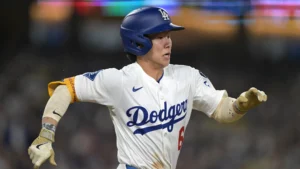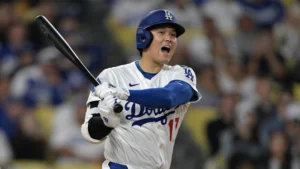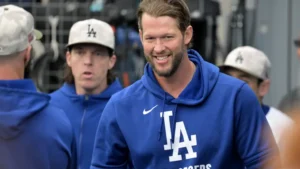
Shohei Ohtani’s legend continues to grow in ways that transcend the numbers, but the numbers are staggering all the same. On a warm night at Dodger Stadium, with over 50,000 fans in attendance and millions more tuned in around the world, Ohtani launched a home run so momentous that it immediately etched his name deeper into the annals of baseball history. As the ball soared into the Los Angeles sky and disappeared into the sea of outstretched arms in the right-field pavilion, the roar that erupted was not just the sound of another Dodger home run. It was the sound of history being made.
This particular blast was not just another highlight-reel moment or an addition to his growing stack of jaw-dropping feats. It was a milestone homer—his 200th career home run in Major League Baseball and his 20th of the current season, already. More significantly, it made Ohtani the first player in MLB history to hit 200 home runs while also having struck out over 600 batters as a pitcher. It’s a statistic so rare, so unfathomable in the modern game, that it essentially belongs to him alone. This wasn’t merely a home run; it was the ultimate validation of what has long been debated: Shohei Ohtani is not just a great baseball player, but perhaps the greatest we’ve ever seen.
The home run came in the bottom of the sixth inning in a pivotal game against a division rival. With the Dodgers clinging to a narrow lead, Ohtani stepped into the batter’s box with two men on base and a full count. Fans held their breath. The pitcher tried to outthink him with a backdoor slider. It hung for a fraction too long, and Ohtani unleashed his trademark swing—short, violent, and perfectly timed. The crack of the bat sounded like a cannon. For a moment, the stadium went silent, as fans traced the ball’s trajectory. When it cleared the wall with plenty to spare, the collective exhale turned into bedlam. Even the Dodgers’ dugout erupted with a mix of awe and childlike glee.
Ohtani rounded the bases calmly, as he always does, but the magnitude of the moment wasn’t lost on anyone. His teammates greeted him with a mix of reverence and joy, aware that they were witnessing something unprecedented. He touched home plate with his usual humility, gave a subtle nod to the sky, and then returned to the dugout, where even veteran stars like Mookie Betts and Freddie Freeman couldn’t contain their excitement. The stadium announcer’s voice cut through the noise: “That’s career home run number 200 for Shohei Ohtani!” The crowd roared again.
For a franchise as storied as the Dodgers, having a global superstar like Ohtani is nothing short of destiny. Signed to a historic $700 million contract this past offseason, Ohtani came to Los Angeles not only to compete for championships but to further build on his legacy. Despite undergoing elbow surgery that has temporarily paused his pitching, Ohtani has continued to mash baseballs with a consistency and ferocity rarely seen. Night after night, he delivers. And with each home run, each opposite-field laser or towering moonshot, he cements himself as the face of baseball’s future.
What makes Ohtani’s accomplishments so singular is the context in which they occur. In an era of specialization, where pitchers are groomed to pitch and hitters are trained solely to hit, Ohtani does both—at elite levels. And he does so while carrying the weight of massive expectations from fans in two countries, constant media attention, and the burden of being the game’s most bankable star. Yet he plays with a calm joy that never seems forced. Whether signing autographs, launching homers, or flashing his signature peace sign in postgame interviews, Ohtani somehow manages to blend global superstardom with the demeanor of a kid still in love with the game.
The historic home run was more than a statistical marvel. It was a moment that crystallized what baseball fans have come to understand over the last five years: Ohtani isn’t just redefining what’s possible in baseball—he’s rewriting the rules entirely. With this latest feat, he now stands alone in a category that didn’t exist before he arrived. No player in modern history—not Babe Ruth, not Willie Mays, not Barry Bonds—has done what Ohtani is doing. The comparisons to Ruth, once made cautiously, now feel inadequate. Ruth pitched and hit, yes, but never simultaneously at this level, and never with the same modern demands. Ohtani is doing this against the most athletic, analytically-prepared competition in history. That’s what makes it all the more remarkable.
Behind the scenes, Ohtani’s discipline is legendary. Teammates and coaches often talk about his meticulous preparation, his relentless work ethic, and his desire to perfect every detail of his game. From film study to biomechanics, diet to recovery routines, Ohtani is an all-in student of the sport. It’s not uncommon to find him in the batting cage hours before games, fine-tuning his swing mechanics. Or in the trainer’s room, going through custom rehabilitation protocols to strengthen his surgically repaired elbow. Every part of his routine is designed with intention and precision. That’s why, even when he’s not taking the mound this season, he still manages to elevate the game around him.
The impact of Ohtani’s historic home run rippled far beyond the ballpark. Social media exploded within seconds. Japanese outlets covered the blast with national fervor, while American networks interrupted programming to show the highlight. International celebrities and athletes posted congratulatory messages. Baseball historians scrambled to update their record books. Major League Baseball’s own platforms released a series of celebratory posts, commemorating Ohtani as the “once-in-a-lifetime” player. But perhaps the most telling reaction came from his peers. Across the league, current and former players showered him with praise, calling him an “alien,” a “baseball god,” and the “best to ever do it.”
As the night wore on, the Dodgers went on to win the game in convincing fashion, and Ohtani’s home run proved to be the turning point. Yet long after the final out was recorded, fans lingered in their seats, hoping to catch one more glimpse of the man who continues to defy logic and precedent. Outside the stadium, fans chanted his name. Some wept. Others danced. Vendors sold out of Ohtani merchandise. And inside the clubhouse, Shohei spoke softly to reporters, as humble as ever. “I’m just trying to help the team win,” he said, before adding, “It’s nice, but I want more. I want to keep getting better.”
That desire—to be better, to never settle—fuels everything Ohtani does. And it’s what makes his journey so captivating. Each milestone, no matter how historic, is treated by him as a step forward, not a final destination. He knows there are more games to play, more homers to hit, and yes, more pitching dominance to return to once his elbow heals. The baseball world, meanwhile, is content to marvel at every step along the way.
In Los Angeles, a city already known for its icons, Ohtani has become more than just a star. He’s a cultural phenomenon. Billboards with his image line the freeways. Children in Little League mimic his swing. Japanese tourists flock to Dodger Stadium wearing his jersey, proud of what he represents. Even longtime Dodgers fans, spoiled by legends like Sandy Koufax and Clayton Kershaw, speak of Ohtani with a different kind of reverence. It’s not just that he’s good—it’s that he’s changing the sport in real time, and doing so with humility, grace, and unrelenting excellence.
The historical home run also brought attention to a fascinating subplot in Ohtani’s career: his rapid approach to some of the game’s most hallowed offensive benchmarks. Despite missing time due to injuries and focusing on pitching during various stretches, Ohtani is now on pace to eclipse 500 career home runs if he remains healthy and productive for the next several seasons. He’s also one of the only players in history with a realistic shot at finishing with both 500 homers and over 1,000 strikeouts as a pitcher—another exclusive club that, if he enters, may remain a party of one forever.
Baseball, a sport rooted in tradition, often resists change. Yet Ohtani has forced the sport to evolve. Scouts are now looking differently at two-way players. Front offices are rethinking roster construction. Kids growing up now dream of being like Ohtani—not just a slugger, not just an ace, but both. His influence is so vast that it has already changed the developmental pipelines in both Japan and the United States.
For the Dodgers, the investment in Ohtani was always about more than just statistics. It was about cultural resonance, competitive dominance, and global impact. And on a night like this, when history is made with a single swing, it becomes clear why they committed to him so fully. In Shohei Ohtani, they didn’t just get a superstar. They got a legend in the making, a player whose every at-bat is a must-watch event and whose every milestone redefines what greatness looks like in the 21st century.
As Ohtani left the field that night, he paused briefly to tip his cap to the crowd. The gesture was simple, yet meaningful. It was his way of acknowledging their support, of sharing the moment with the fans who fuel him. But it also carried the quiet confidence of a man who knows he’s far from done. More records will fall. More jaws will drop. More history will be written. And as the baseball world continues to marvel at the Shohei Show, one thing is certain: we are all witnesses to an era we may never see again.





